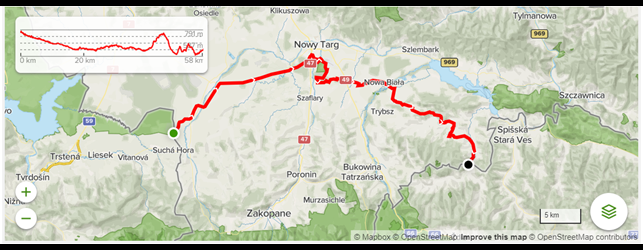What
Cooperation between Polish and Slovakian authorities can be traced back to 1990s when they co-initiated the Euroregion TATRY. Over the years, several initiatives have been carried out to valorise the countries’ shared heritage in the Tatras mountains which includes old settlements, former trade routes, architectural monuments, Gothic wooden churches, wooden traditional architecture, as well as unique natural and scenic landscapes. The area also boasts 15 sites that are included in the UNESCO World Heritage List. To further this valorisation of the historical, cultural and natural areas the Euroregion also signed an agreement initiating the project,The Cycling Route around the Tatra Mountains.
The project designed a scheme to create of a loop of more than 250 km of cycling paths, some of which can also be used for skiing and running, between Poland and Slovakia, encircling several of the abovementioned areas. Stage one of the cycling route was financed in 2014 and completed with nearly 100 km of paths, including a 35 kmcross-border section built on the embankment of a former railway line that dates to the Austro-Hungarian Empire. Plus, bridges were repaired, and 15 resting places developed. The second stage of the project plans to continue with the construction of the trails as well as with leisure and accommodation infrastructure.
The project is local governments’ answer to the lack of proper tourist infrastructure, such as appropriate signage, which hampers the full realisation of the area’s touristic potential, by inhabitants, tourists and investors alike. It is hoped that the new facilities will act as a catalyst for business development in sectors like food and accommodation, guide services, and bike and ski rentals.
Who
The project is managed by the EGTC TATRY – a joint Polish-Slovakian legal entity established under EU law in 2013, a formal upgrade from the previously established Euroregion. The EGTC participates actively and with different roles in the implementation of the Interreg V-A Poland-Slovakia 2014-2020 Programme. The partnership is composed of 9 local governments - 4 from Poland and 5 from Slovakia.
After the project, the partners will continue to cooperate on the preparation of further stages of this investment. Moreover, the scope of the partnership will be constantly extending – as more and more places are included along the route.
Where

How?
The project was funded in the framework of the cross-border cooperation programme Interreg Poland-Slovakia 2014-2020, with an ERDF contribution of around 4.8m EUR. The investment falls under the programme’s priority “Protection and development of the cross-border area's natural environmental and cultural heritage” and ran from November 2016 to April 2019.
Results
Thanks to this initiative, the Tatra Mountains have stopped being a barrier and became something which unites Poles and Slovaks. The activities of stage II of the project resulted in the construction of further 59.44 km of cycling routes, together with 14 resting places and a free park-and-ride facility. Moreover, the dedicated website has been renovated and extended, including comprehensive information about the trail and nearby local attractions. In addition, maps and guidebooks about the route have been published in paper format and as e-books. The project team organised also a competition to design the cycling trail’s logo. Plus, a series of outdoor events and study visits were held in 2019 for representatives from local authorities and tourism bodies engaged in bike tourism from the entire borderland area, as well as workshops on the development of cycling infrastructure in the borderland. The project participates in the wider programme ‘The Polish Tourism Brand’ implemented by the Polish Ministry of Sport and Tourism.
Despite some difficulties in the coordination between the numerous entities and in dealing with burdensome procedures for project realisation and accounting, the involvement of the EGTC proved to be ideal to manage such strategic territorial cooperation projects, as it facilitates the smooth preparation and implementation of the project. Polish and Slovak staff of the EGTC familiar with their own national legal requirements and administrative procedures, including building laws and tendering procedures, proved to be useful in easily and quickly overcoming various bottlenecks.
As a result of the project, the attractiveness of the borderland region has increased substantially, and the project has also been an answer to the current needs of developing alternative and eco-friendly means of travelling and forms of leisure. Due to the increasing interest in new cycling paths and cycling tourism, numerous local business activities developed near the Tatra Route such as rentals, bike or ski facilities, hospitality businesses and touristic and mountain guide centres all of which contribute to the wider economic development of the cross-border region.
More information
- Piesakieties sistēmā, lai varētu publicēt komentārus
- Tagi
- green deal employment

